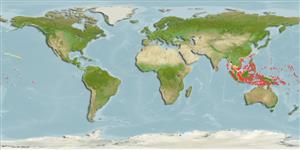Environment: milieu / climate zone / depth range / distribution range
पारिस्थितिकी
समुद्री प्रवाल-भित्ति संयुक्त; गहराई सीमा 20 - 50 m (Ref. 90102). Tropical; 30°N - 12°S
Western Pacific: southern Honshu, Japan to the Great Barrier Reef and New Caledonia. Reported from the Similan Islands in the Andaman Sea and Guam. Recently recorded from Tonga (Ref. 53797).
आकार / वज़न / Age
Maturity: Lm ? range ? - ? cm
Max length : 60.0 cm SL पुल्लिंग / अलिंग; (Ref. 48637)
पृष्ठीय रीढ़ (सम्पूर्ण) : 5; पृष्ठीय सौफट रेज़ (सम्पूर्ण) : 27 - 30; गुदा कांटा: 2; ऐनल सौफट रेज़: 26 - 30. Lacks a horn, has numerous black close-set spots on the upper half of its body and tail, and is white ventrally. Body elongate, its depth 3.3 to 3.7 times in SL (Ref 9808).
Inhabits coastal to outer reef slopes subject to strong currents. Sometimes in large schools (Ref. 48637). Generally uncommon species found in steep outer reef drop-offs (Ref. 9710). Usually found in waters deeper than 6 m. Feeds on zooplanktons (Ref. 90102). Solitary or in groups (Ref. 37816).
Life cycle and mating behavior
Maturities | पुनरुत्पत्ति | Spawnings | Egg(s) | Fecundities | लार्वा
Myers, R.F., 1991. Micronesian reef fishes. Second Ed. Coral Graphics, Barrigada, Guam. 298 p. (Ref. 1602)
IUCN Red List Status (Ref. 130435)
Threat to humans
Harmless
Human uses
मात्स्यिकी: व्यापारिक; जलजीवालय: व्यापारिक
साधन
Special reports
Download XML
इंटरनेट स्रोत
Estimates based on models
Preferred temperature (Ref.
123201): 24.4 - 28.5, mean 27.6 °C (based on 73 cells).
Phylogenetic diversity index (Ref.
82804): PD
50 = 0.5000 [Uniqueness, from 0.5 = low to 2.0 = high].
Bayesian length-weight: a=0.01995 (0.00906 - 0.04395), b=3.00 (2.82 - 3.18), in cm total length, based on LWR estimates for this Genus-body shape (Ref.
93245).
Trophic level (Ref.
69278): 2.9 ±0.33 se; based on food items.
लौटाव (Ref.
120179): माध्यम, न्यूनतम जनसंख्या दुगनी होने का समय 1.4 - 4.4 वर्ष। (Preliminary K or Fecundity.).
Fishing Vulnerability (Ref.
59153): Moderate to high vulnerability (49 of 100).
Nutrients (Ref.
124155): Calcium = 32.3 [20.0, 58.7] mg/100g; Iron = 0.564 [0.286, 0.969] mg/100g; Protein = 18.8 [17.7, 19.8] %; Omega3 = 0.127 [0.079, 0.236] g/100g; Selenium = 34.6 [18.2, 62.7] μg/100g; VitaminA = 91.3 [32.2, 256.9] μg/100g; Zinc = 1.14 [0.79, 1.60] mg/100g (wet weight);
